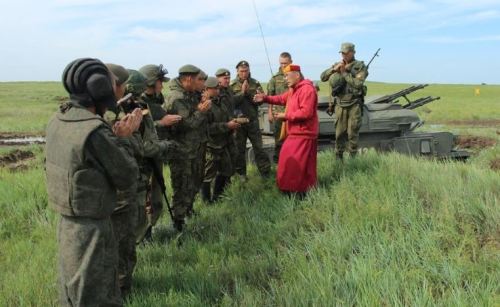Russian media covering the armed forces still have moments. Take Ulan-Ude’s Buryaad Unen. Hat tip to bmpd for covering dambiev who in turn covered this Buryat piece.

Buryaad Unen told the story of the Russian military’s only Buddhist “chaplain” — Bair Batomunkuyev. Bair Lama has served six years as “assistant to the commander for work with religious servicemen” (troop priest) in Kyakhta’s 37th Independent Motorized Rifle Brigade.
He was a conscript repairing communications in a radar unit in Yakutia from 1988 to 1990. He wasn’t a very observant Buddhist as a youth although he went with his grandmother to pray at holy places and learned mantras from her.
While serving, he nearly froze to death in a snowstorm and is convinced he survived by thinking of his grandmother and repeating prayers she taught him. A search party rescued him.
He finished his military time and went to study at the Buddhist monastery in Ivolginsk, not far from Ulan-Ude. His grandmother was very happy.
In 2003-2004, Bair Lama answered a request from Kyakhta’s border guards detachment for “spiritual support.” In 2012, the MR brigade offered him a position.
He has met other “priests” working in his capacity, mainly Russian Orthodox of course. According to him, there are three Muslims serving as “assistant commanders for work with religious believers” but only one Buddhist. There are, he says, many Buddhist servicemen and they serve well. Buryat-tankers regularly win prizes in the annual Tank Biathalon, according to Bair.
Bair Lama says the situation in his formation is normal and orderly. He reports directly to the brigade commander, but also to the chief of the section for work with religious servicemen in the Eastern MD staff.
The interviewer asks Bair if the army contradicts his religious convictions given Buddhism’s principles of non-violence and compassion for all living things. He responds:
“The security of my family and relatives, our peoples and state is in the balance. As Napoleon Bonaparte said: ‘A people not wishing to feed its own army will soon have to feed a foreign one.’”
“Absolute pacifism is not characteristic of Buddhism for a follower of Buddha’s Teaching will not remain a passive and passionless bystander of evil and violence, but actively opposes it with compassion for all living things. One of the manifestations of this principle closest to us in time is the participation of Buddhists in the Great Patriotic War. Not just lay Buddhists but even ordained monk-lamas who’d received a Buddhist education without reservation took up weapons and went to war. By the same token, Buddhist Teaching doesn’t impose restrictions on carrying out military service in peacetime. The weapon in itself is not terrible and the nature of the action (peaceful or wrathful by necessity) is not important, but the motivation (compassion toward living things), the essence (goodness) and the purpose of the action (the good of living things).”
How many Russian Federation citizens are Buddhist? Hard to say. Maybe as few as 700,000 or as many as 1.5 million. The Kremlin may not even have an accurate estimate.
The largest concentrations are in Buryatia, Tuva, and Kalmykia. Their combined populations are about 1.5 million. Obviously not all their residents are Buddhists, and, similarly, not all Buddhists in the Russian Federation live those regions.
The number 700,000 is likely an underestimate; 1.5 million might be correct or just somewhat inflated.
Recall that former defense minister Anatoliy Serdyukov started putting clergymen in MOD units to promote better order, discipline, and inter-ethnic accord. They were somewhat intended to replace deputy commanders for “socialization” work — old zampolits — that Serdyukov dismissed to shrink the officer corps.
The first Russian Orthodox priests became “assistant commanders for work with religious believers” in 2010. In 2017, the ROC reported there were 176 priests attached to military units with another 45 in the pipeline.
But only three mullahs? One lama? No rabbis?
From the outset the Russian MOD said clergy would be appointed, probably to brigades and divisions, on a proportional basis. That presupposed (probably unreasonably) comprehensive knowledge of the beliefs of Russian Federation soldiers as a group.
The numbers 3, 1, and 0 are clearly not proportional. In 2009, the MOD figured 90 percent of clergymen in the ranks would be Orthodox priests. But with 20 million Muslims living in the RF, Muslim troops are certainly underserved with just three mullahs in the ranks. The Eastern MD itself said 8 percent of its spring conscripts in 2016 were Muslim and 4 percent Buddhist.
But the MOD’s avoidance of mono-ethnic (and mono-religious) units and its extraterritoriality policy (not allowing draftees to serve in their home regions) have mixed conscripts from many areas and ensured that Russians (and Orthodox Christians) predominate in any military unit. Hence, if there’s any priest, he’s ROC.
Taking it further though, three mullahs and one lama tells us there may be, at least, three predominately Muslim units and one “Buddhist” (Buryat or Tuvan) unit in the RF Armed Forces.
Under Serdyukov, the MOD toyed with forming mono-ethnic units to end frequent conflict between Russian troops and soldiers from Dagestan. Perhaps some majority Muslim units were formed. Which ones are hard to say. But under Sergey Shoygu, the MOD definitely formed a majority Tuvan (likely majority Buddhist) formation — Kyzyl’s 55th Independent Motorized Rifle Brigade (Mountain), but it doesn’t have its own lama.
Bair Lama’s position tells us the 37th IMRB in Kyakhta is a majority Buryat, majority Buddhist formation. Kalmykia, though majority Buddhist, basically has no MOD units.
It seems safe to conclude the Russian MOD doesn’t have much intention to go further with mono-ethnic or mono-religious units, or to put more clergymen out among the troops except Orthodox priests.
- Russia Denies Reports Of Its Troops Being Killed In Syria
- Putin Makes Moves To Stay In Power Past End Of Term

